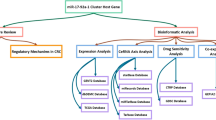Abstract
Background
MicroRNAs (miRNAs) play a critical role in the carcinogenesis and progression of breast cancer. MiRNA-205 has tumor suppressive properties, whereas miRNA-18a has both oncogenic and tumor suppressive roles. MiRNA-744’s role in breast cancer is unknown but is tumor-suppressive in vitro. We hypothesize that high expression of all three miRNAs is associated with a better survival based on their known functions in breast cancer.
Methods
All data was obtained from the Cancer Genome Atlas (TCGA). Expression patterns of miRNA-18a, miRNA-205, and miRNA-744 were retrieved from the Genomic Data Commons (GDC) data portal for analyses. After miRNA-specific thresholds were derived and used to group the patients into a high- or low-expression group, survival data was calculated by using the Cox proportional hazard model. Further subanalyses separating the patients based on receptor status and AJCC 7th edition TNM staging were similarly compared.
Results
In total, 1,052 of 1,097 samples logged in TCGA had clinical data and miRNA-sequence datasets on the miRNAs of interest. High expression of miRNA-18a (p = 0.079), miRNA-205 (p = 0.034), and miRNA-744 (p = 0.0135) was associated with better survival. On subanalysis, estrogen receptor (ER)-positive, progesterone receptor (PR)-positive, and lymph node-negative disease had a statistically significant survival advantage with miRNA-18a, miRNA-205, and miRNA-744 high expression.
Conclusions
By utilizing a big dataset (TCGA) with sufficient statistical power, we found that high expression of miRNA-18a, miRNA-205, and miRNA-744 in the breast tumor samples were all associated with better overall survival in ER/PR-positive, lymph node-negative disease supporting their role as a tumor suppressor in breast cancer.




Similar content being viewed by others
References
Piletic K, Kunej T. MicroRNA epigenetic signatures in human disease. Arch Toxicol. 2016;90(10):2405–19.
Bertoli G, Cava C, Castiglioni I. MicroRNAs: New biomarkers for diagnosis, prognosis, therapy prediction and therapeutic tools for breast cancer. Theranostics. 2015;5(10):1122–43.
Guo X, Yang C, Qian X, et al. Estrogen receptor alpha regulates ATM Expression through miRNAs in breast cancer. Clin Cancer Res. 2013;19(18):4994–02.
Yoshimoto N, Toyama T, Takahashi S, et al. Distinct expressions of microRNAs that directly target estrogen receptor alpha in human breast cancer. Breast Cancer Res Treat. 2011;130(1):331–49.
Krutilina R, Sun W, Sethuraman A, et al. MicroRNA-18a inhibits hypoxia-inducible factor 1alpha activity and lung metastasis in basal breast cancers. Breast Cancer Res. 2014;16(4):R78.
Mouw JK, Yui Y, Damiano L, et al. Tissue mechanics modulate microRNA-dependent PTEN expression to regulate malignant progression. Nat Med. 2014;20(4):360–67.
Wu H, Zhu S, Mo YY. Suppression of cell growth and invasion by miR-205 in breast cancer. Cell Res. 2009;19(4):439–48.
Lee JY, Park MK, Park JH, et al. Loss of the polycomb protein Mel-18 enhances the epithelial-mesenchymal transition by ZEB1 and ZEB2 expression through the downregulation of miR-205 in breast cancer. Oncogene. 2014;33(10):1325–35.
Gandellini P, Folini M, Longoni N, et al. miR-205 Exerts tumor-suppressive functions in human prostate through down-regulation of protein kinase Cepsilon. Cancer Res. 2009;69(6):2287–95.
Zhang G, Hou X, Li Y, Zhao M. MiR-205 inhibits cell apoptosis by targeting phosphatase and tensin homolog deleted on chromosome ten in endometrial cancer Ishikawa cells. BMC Cancer. 2014;14:440.
Vislovukh A, Kratassiouk G, Porto E, et al. Proto-oncogenic isoform A2 of eukaryotic translation elongation factor eEF1 is a target of miR-663 and miR-744. Br J Cancer. 2013;108(11):2304–11.
Chen XF, Liu Y. MicroRNA-744 inhibited cervical cancer growth and progression through apoptosis induction by regulating Bcl-2. Biomed Pharmacother. 2016;81:379–87.
Zhou W, Li Y, Gou S, et al. MiR-744 increases tumorigenicity of pancreatic cancer by activating Wnt/beta-catenin pathway. Oncotarget. 2015;6(35):37557–69.
Chin L, Andersen JN, Futreal PA. Cancer genomics: from discovery science to personalized medicine. Nat Med. 2011;17(3):297–03.
Ramanathan R, Olex AL, Dozmorov M, Bear HD, Fernandez LJ, Takabe K. Angiopoietin pathway gene expression associated with poor breast cancer survival. Breast Cancer Res Treat. 2017;162(1):191–98.
Comprehensive molecular portraits of human breast tumours. Nature. 2012;490(7418):61–70.
Weinstein JN, Collisson EA, Mills GB, et al. The Cancer Genome Atlas Pan-Cancer analysis project. Nat Genet. 2013;45(10):1113–20.
Tomczak K, Czerwinska P, Wiznerowicz M. The Cancer Genome Atlas (TCGA): an immeasurable source of knowledge. Contemporary Oncol. 2015;19(1a):A68–A77.
Liu WH, Yeh SH, Lu CC, et al. MicroRNA-18a prevents estrogen receptor-alpha expression, promoting proliferation of hepatocellular carcinoma cells. Gastroenterology. 2009;136(2):683–93.
Shidfar A, Costa FF, Scholtens D, et al. (2017) Expression of miR-18a and miR-210 in Normal Breast Tissue as Candidate Biomarkers of Breast Cancer Risk. Cancer Prevention Research 10(1):89–97.
Tsuchida J, Nagahashi M, Rashid OM, Takabe K, Wakai T. At what age should screening mammography be recommended for Asian women? Cancer Med. 2015;4(7):1136–44.
Gregory PA, Bert AG, Paterson EL, et al. The miR-200 family and miR-205 regulate epithelial to mesenchymal transition by targeting ZEB1 and SIP1. Nature Cell Biol. 2008;10(5):59301.
Miyamae M, Komatsu S, Ichikawa D, et al. Plasma microRNA profiles: identification of miR-744 as a novel diagnostic and prognostic biomarker in pancreatic cancer. Br J Cancer. 2015;113(10):1467–76.
TCGA Data Portal. Available at: https://tcga-data.nci.nih.gov/docs/publications/tcga/? Accessed 5 June 2017.
Disclosure
All authors declare that they have no financial relationships or conflicts of interest.
Author information
Authors and Affiliations
Corresponding author
Rights and permissions
About this article
Cite this article
Kim, S.Y., Kawaguchi, T., Yan, L. et al. Clinical Relevance of microRNA Expressions in Breast Cancer Validated Using the Cancer Genome Atlas (TCGA). Ann Surg Oncol 24, 2943–2949 (2017). https://doi.org/10.1245/s10434-017-5984-2
Received:
Published:
Issue Date:
DOI: https://doi.org/10.1245/s10434-017-5984-2




